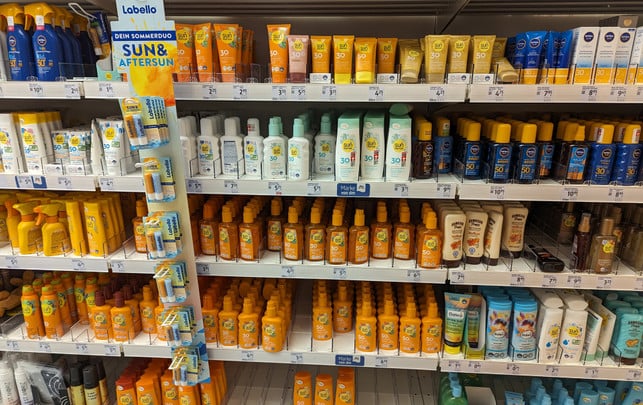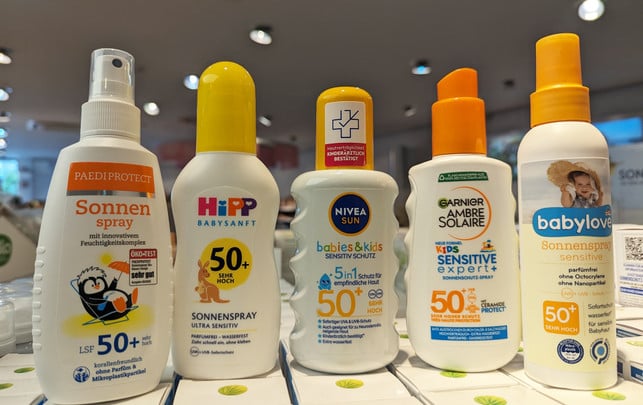
Sun protection spray is practical: it can be easily applied compared to creams from tubes or bottles and is helpful when it comes to reaching back and shoulders. But is it just as effective as sunscreen? We asked an expert.
Sun provides a good mood and summer feeling for many people – but we have to protect ourselves from their dangers. Keyword: sunscreen. Applied correctly, the sun protection preserves the skin from the dangerous UVA and UVB rays and reduces the risk of skin cancer, sunburn, premature skin aging and unsightly skin discoloration.
Sun spray or sunscreen?
The selection of sunscreen in the drugstore is huge – it is difficult to decide which one should now buy:
- Light protection factor 20, 30 or 50?
- Do children need special children’s sunscreen?
- Which sunscreens have best cut off in tests?
- The question is also important: sun spray or sunscreen?
We wanted to know whether a sun protection spray or a traditional lotion from the tube or bottle is the better choice.

Is sun protection spray as effective as Lotion?
The short answer is: Yes. The different sunscreen alternatives differ in their texture, but not in their effect. That means: products with the same light protection factor and the same UVA classification are equally good in protecting the skin. “The manufacturers themselves make sure that their products meet the SPSF and UVA protection that their products fulfill,” explains Christine Throl, editor at ÖKO-Test and responsible for the tests of sunscreen. Of course, the prerequisite is always that the products are applied correctly.
So whether you are rubbing with a sun protection cream with LSF 50 or spraying a lot of a sun protection spray with SPF 50 into your hand and cleaning up with it – the effect is the same. The situation is different if you spray on the skin with the spray.
What speaks for and against sun protection sprays?
The biggest advantage of sun protection sprays is that they are practical. Spraying many people is more fun than cream. But there are also some points that clearly speak for the cream variant and against the spray: sprays are often applied too sparingly, their application is only recommended if no breeze blows and should not be inhaled either.
“As a dermatologist, I am not a fan of sun sprays,” said Christoph Liebich, a resident dermatologist in Munich. For a simple reason: “Most of the cream does not arrive on the skin at Sprays”.
Expert tips for the use of sun spray
Anyone who uses sun sprays should take the following points into account:
#1: Do not apply the sun protection spray too economically
Hardly anyone knows how much sunscreen is really necessary to protect the skin. “It is 2 milligrams of sunscreen per centimeter of the skin,” explains Christoph Liebich and calculates: “With a 1.80 meter tall person, the need is 20 to 25 milliliters of sunscreen. Application for each time.” That is around three to four tablespoons.
The Harvard Medical School points out that most people are particularly economical when applying sun protection sprays: “Studies on sun protection sprays show that many people only apply a quarter of the amount required. In order to achieve a sun protection factor (SPSF) similar to a lotion or a gel, they have to spray every part of the body for up to six seconds.”
#2: Sun protection sprays are not suitable for the face
The US Food and Drug Administration (FDA) advises to apply sun protection sprays near the face. The spray can irritate the lungs when inhaling, especially in people with diseases such as asthma.
#3: Apply sun protection sprays only in windless locations
A study by Griffith University in Brisbane examined the loss of sunscreen when using sprays for various wind strengths: Even with a slight breeze of 10 km/h, the researcher: Inner team has observed a sunscreen loss of 54 percent. “On windy days, Australians who use aerosol sun protection could waste up to 93 % of their bottle, since the sun protection is carried into the environment by the wind where it can have follows for the coastal ecosystems,” explains Dr. Elke Hacker, senior research assistant at the Menzies Health Institute Queensland at Griffith University. Of course, this also applies in all other places in the world.

When is the sun spray sensible?
The dermatologist Christoph Liebich recommends sunscreen in spray form, for example, acne patient: inside. “The sprays often have a lower fat content and are therefore better suited for sensitive acne skin”.
His tip: “Spray the sun protection better – and not directly on the body – and then apply the cream like ordinary sun lotion”. Then you know what really matters on the skin.
Even if things have to go quickly or in children who vehemently resist the cream, a sun spray and the associated funny spray campaign is often the key to success. Because the motto is: No matter what kind of sun protection you choose – the main thing is that you protect your skin – and that of your children – from dangerous radiation.
Read more on utopia.de:
- Old sunscreen: Can you still use the cream from the previous year?
- Apply sunscreen correctly: avoid these 6 errors
- Stycation: 6 tips for a sustainable vacation at home
** marked with ** or orange underlined Links to sources of supply are partially partner links: If you buy here, you will actively support Techzle\.com, because we will then receive a small part of the sales proceeds. More information.